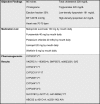Precision medication: An illustrative case series guiding the clinical application of multi-drug interactions and pharmacogenomics
- PMID: 32128178
- PMCID: PMC7044418
- DOI: 10.1002/ccr3.2604
Precision medication: An illustrative case series guiding the clinical application of multi-drug interactions and pharmacogenomics
Abstract
Precision medication entails selecting the precise medication, dose, and timing of administration. Multi-drug interactions and genetics significantly affect precision medication. In this article, we present two simulated cases for real-world applications of precision medication. Clinicians may need to acquire additional skills to apply the principles illustrated by these cases.
Keywords: drug interactions; pharmacogenomics; phenoconversion; precision medication; precision medicine.
© 2019 The Authors. Clinical Case Reports published by John Wiley & Sons Ltd.
Conflict of interest statement
The authors disclose that they performed this work as employees of Tabula Rasa HealthCare and that they possess shares and/or stock options in the aforementioned company.
Figures


 = CYP weak affinity substrate,
= CYP weak affinity substrate,  = CYP moderate affinity substrate, and
= CYP moderate affinity substrate, and  = CYP strong affinity substrate. The percentages in the cells for CYP450 drug‐metabolizing isoenzymes indicate the extent this isoenzyme contributes to the overall metabolic clearance of the medication. aIndicates a prodrug
= CYP strong affinity substrate. The percentages in the cells for CYP450 drug‐metabolizing isoenzymes indicate the extent this isoenzyme contributes to the overall metabolic clearance of the medication. aIndicates a prodrug

 = CYP weak affinity substrate,
= CYP weak affinity substrate,  = CYP moderate affinity substrate, and
= CYP moderate affinity substrate, and  = CYP strong affinity substrate. The percentages in the cells for CYP450 drug‐metabolizing isoenzymes indicate the extent this isoenzyme contributes to the overall metabolic clearance of the medication. aIndicates a prodrug
= CYP strong affinity substrate. The percentages in the cells for CYP450 drug‐metabolizing isoenzymes indicate the extent this isoenzyme contributes to the overall metabolic clearance of the medication. aIndicates a prodrugSimilar articles
-
History repeats itself: the family medication history and pharmacogenomics.Pharmacogenomics. 2016 May;17(7):669-78. doi: 10.2217/pgs-2015-0015. Epub 2016 May 4. Pharmacogenomics. 2016. PMID: 27143300
-
Illustrative and historic cases of phenoconversion.Am J Transl Res. 2021 Dec 15;13(12):13328-13335. eCollection 2021. Am J Transl Res. 2021. PMID: 35035679 Free PMC article. Review.
-
Pharmacogenomics and Drug-Induced Phenoconversion Informed Medication Safety Review in the Management of Pain Control and Quality of Life: A Case Report.J Pers Med. 2022 Jun 15;12(6):974. doi: 10.3390/jpm12060974. J Pers Med. 2022. PMID: 35743759 Free PMC article.
-
A Web-Based Pharmacogenomics Search Tool for Precision Medicine in Perioperative Care.J Pers Med. 2020 Jul 21;10(3):65. doi: 10.3390/jpm10030065. J Pers Med. 2020. PMID: 32708157 Free PMC article.
-
Clinical Pharmacogenomics: Applications in Nephrology.Clin J Am Soc Nephrol. 2018 Oct 8;13(10):1561-1571. doi: 10.2215/CJN.02730218. Epub 2018 May 23. Clin J Am Soc Nephrol. 2018. PMID: 29793969 Free PMC article. Review.
Cited by
-
Opioids, Polypharmacy, and Drug Interactions: A Technological Paradigm Shift Is Needed to Ameliorate the Ongoing Opioid Epidemic.Pharmacy (Basel). 2020 Aug 25;8(3):154. doi: 10.3390/pharmacy8030154. Pharmacy (Basel). 2020. PMID: 32854271 Free PMC article.
-
Evaluating the Impact of Medication Risk Mitigation Services in Medically Complex Older Adults.Healthcare (Basel). 2022 Mar 16;10(3):551. doi: 10.3390/healthcare10030551. Healthcare (Basel). 2022. PMID: 35327028 Free PMC article.
-
Effectiveness of an Advanced Clinical Decision Support System on Clinical Decision-Making Skills in a Call Center Medication Therapy Management Pharmacy Setting: A Pilot Study.Pharmacy (Basel). 2020 Nov 25;8(4):228. doi: 10.3390/pharmacy8040228. Pharmacy (Basel). 2020. PMID: 33255726 Free PMC article.
References
-
- Preskorn SH, Kane CP, Lobello K, et al. Cytochrome P450 2D6 phenoconversion is common in patients being treated for depression: implications for personalized medicine. J Clin Psychiatry. 2013;74:614‐621. - PubMed
-
- Zakrzewski‐Jakubiak H, Doan J, Lamoureux P, Singh D, Turgeon J, Tannenbaum C. Detection and prevention of drug‐drug interactions in the hospitalized elderly: utility of new cytochrome p450‐based software. Am J Geriatr Pharmacother. 2011;9:461‐470. - PubMed
-
- Doan J, Zakrzewski‐Jakubiak H, Roy J, Turgeon J, Tannenbaum C. Prevalence and risk of potential cytochrome P450‐mediated drug‐drug interactions in older hospitalized patients with polypharmacy. Ann Pharmacother. 2013;47:324‐332. - PubMed
-
- Verbeurgt P, Mamiya T, Oesterheld J. How common are drug and gene interactions? Prevalence in a sample of 1143 patients with CYP2C9, CYP2C19 and CYP2D6 genotyping. Pharmacogenomics. 2014;15:655‐665. - PubMed
Publication types
LinkOut - more resources
Full Text Sources

